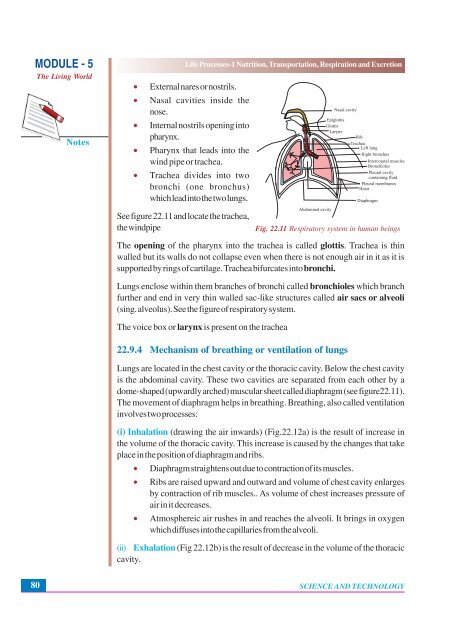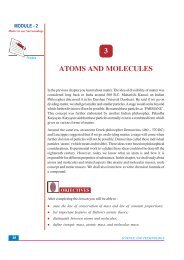Nutrition, Transportation, Respiration and Excretion
Nutrition, Transportation, Respiration and Excretion
Nutrition, Transportation, Respiration and Excretion
You also want an ePaper? Increase the reach of your titles
YUMPU automatically turns print PDFs into web optimized ePapers that Google loves.
MODULE - 5<br />
The Living World<br />
Notes<br />
• External nares or nostrils.<br />
Life Processes-1 <strong>Nutrition</strong>, <strong>Transportation</strong>, <strong>Respiration</strong> <strong>and</strong> <strong>Excretion</strong><br />
• Nasal cavities inside the<br />
nose.<br />
• Internal nostrils opening into<br />
pharynx.<br />
• Pharynx that leads into the<br />
wind pipe or trachea.<br />
• Trachea divides into two<br />
bronchi (one bronchus)<br />
which lead into the two lungs.<br />
See figure 22.11 <strong>and</strong> locate the trachea,<br />
the windpipe<br />
Fig. 22.11 Respiratory system in human beings<br />
The opening of the pharynx into the trachea is called glottis. Trachea is thin<br />
walled but its walls do not collapse even when there is not enough air in it as it is<br />
supported by rings of cartilage. Trachea bifurcates into bronchi.<br />
Lungs enclose within them branches of bronchi called bronchioles which branch<br />
further <strong>and</strong> end in very thin walled sac-like structures called air sacs or alveoli<br />
(sing. alveolus). See the figure of respiratory system.<br />
The voice box or larynx is present on the trachea<br />
22.9.4 Mechanism of breathing or ventilation of lungs<br />
Lungs are located in the chest cavity or the thoracic cavity. Below the chest cavity<br />
is the abdominal cavity. These two cavities are separated from each other by a<br />
dome-shaped (upwardly arched) muscular sheet called diaphragm (see figure22.11).<br />
The movement of diaphragm helps in breathing. Breathing, also called ventilation<br />
involves two processes:<br />
(i) Inhalation (drawing the air inwards) (Fig.22.12a) is the result of increase in<br />
the volume of the thoracic cavity. This increase is caused by the changes that take<br />
place in the position of diaphragm <strong>and</strong> ribs.<br />
• Diaphragm straightens out due to contraction of its muscles.<br />
• Ribs are raised upward <strong>and</strong> outward <strong>and</strong> volume of chest cavity enlarges<br />
by contraction of rib muscles.. As volume of chest increases pressure of<br />
air in it decreases.<br />
• Atmosphereic air rushes in <strong>and</strong> reaches the alveoli. It brings in oxygen<br />
which diffuses into the capillaries from the alveoli.<br />
(ii) Exhalation (Fig 22.12b) is the result of decrease in the volume of the thoracic<br />
cavity.<br />
80<br />
SCIENCE AND TECHNOLOGY
















